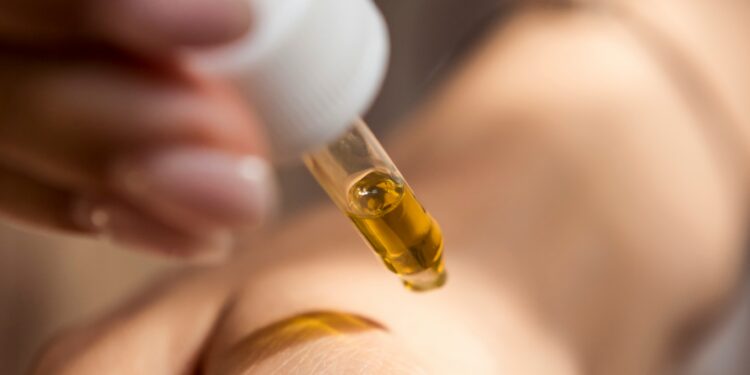In an algorithm where hashtags outrun journal articles, Gen Z’s dermatology now happens one swipe at a time. A national survey of 1,172 U.S. women aged 18-29 found that 65.5 percent intentionally seek health advice on TikTok and 92 percent encounter it unintentionally (JMIR Infodemiology, 2024). Pediatric dermatologists meanwhile report a jump in rashes, irritant dermatitis, and premature barrier damage tied to influencer-driven “10-step routines.” The first peer-reviewed study of teen #SkinTok videos—in Pediatrics—logged an average of 11 active ingredients per routine, yet sunscreen appeared in only 26 percent of daytime regimens (Pediatrics, 2024).
The disconnect is widening: medical providers preach gentle cleansers and SPF; the feed shouts exfoliating acids, copper-infused serums, and freshly mainstream NAD⁺ boosters. Can evidence catch up to virality? And do buzzy molecules such as nicotinamide adenine dinucleotide or GHK-Cu peptides merit the hype—or simply trend with the algorithm?
1 | The Algorithm as Amateur Dermatologist
TikTok’s engagement loop rewards novelty over nuance. Northwestern Medicine researchers catalogued 78 unique products in the top 50 teen skin-care videos; only three contained SPF (Northwestern Now, 2024). Dermatologist Hallie McDonald warns that these multi-active regimens can trigger lifelong sensitizers like allergic contact dermatitis (Dermatology Times, 2025).
Why do teens trust the feed? Cognitive scientists point to the availability heuristic—repeat exposure feels like verification. Add aspirational aesthetics—pristine bathrooms, dewy cheeks—and the platform becomes a glossy infomercial for unvetted claims.
2 | Skipping the Clinic: What the Numbers Say
- 38 percent of young adults admit they ignored or delayed professional advice after seeing contradictory content on social media (Dermatology Online Journal, 2024).
- One in five Gen Z users bought at least one product solely because it was trending on #SkinTok, according to an Axiom/Ipsos poll, 2025.
- Google Trends shows an eight-fold, five-year rise in searches for “how to layer acids” versus flat interest in “find a dermatologist,” underscoring the credibility gap (Google Trends).
Clinicians face an unprecedented marketing rival: influencers offer immediacy, relatability, and peer validation; medical appointments present wait-lists, co-pays, and jargon.
3 | Ingredient of the Moment — NAD⁺ Boosters
3.1 What It Is
Nicotinamide adenine dinucleotide (NAD⁺) is a co-enzyme essential for mitochondrial energy and DNA repair, gradually declining with age and UV exposure.
3.2 What the Science Says
In-vitro data published in Cells show topical NAD⁺ protected human fibroblasts from UV-induced oxidative stress by 34 percent (Cells, 2024). A review in Regenerative Medicine links systemic NAD⁺ repletion to enhanced wound healing and barrier recovery (Regenerative Medicine, 2024).
3.3 Caveats
Most studies remain pre-clinical. The large NAD⁺ molecule penetrates skin poorly; many serums rely on precursors such as NMN, whose topical efficacy is unproven. Over-supplementation can provoke flushing, headaches, or irritation—especially when layered with the acids popular on #SkinTok.
3.4 Prestige 2.0’s Protocol
Northwest Indiana’s Prestige 2.0 integrates NAD⁺ IV infusions and physician-formulated serums only after patch testing and VISIA imaging assessments, emphasizing that “TikTok compresses years of lab work into a 30-second commercial,” in the words of co-founder Dr. Jay Joshi.
4 | The Blue-Blood Buzz — GHK-Cu (Copper Peptide)
4.1 Origins & Mechanisms
Discovered in 1973, GHK-Cu modulates wound healing, stimulates collagen, and exerts anti-inflammatory effects.
4.2 Evidence Snapshot
A 12-week, placebo-controlled study of 71 women with photo-aged skin found that GHK-Cu cream reduced wrinkle depth by 32.8 percent versus control (International Journal of Cosmetic Science, 2022). Additional in-vitro work shows up-regulation of integrins and metalloproteinases critical for extracellular-matrix remodeling (Journal of Peptide Science, 2023).
4.3 TikTok vs. Trials
Where trials used about 0.05 percent GHK-Cu, influencer “dupe recipes” urge DIY cocktails with crushed copper supplements—risking free copper-ion oxidation. Dermatologist Alexis Stephens cautions: “Chelated GHK-Cu is the bio-available form; free copper can catalyze radical damage” (Allure, 2025).
4.4 Prestige 2.0’s Guardrails
Prestige 2.0 compounds 0.05 percent GHK-Cu in barrier-supportive bases, introduced after acid and retinoid tolerance is documented, with tele-derm follow-ups to catch early irritation.
5 | The Four-Step Misinformation Pipeline
- Seed Video – Influencer demos a three-acid stack plus NAD⁺ mist.
- Echo Chamber – Duets replicate the hack; algorithm amplifies based on watch time.
- Brand Surge – White-label sellers flood marketplaces with look-alike serums of unknown concentration.
- Clinical Fallout – Clinics treat dermatitis weeks later; meanwhile, the original clip sinks into the algorithmic abyss.
TikTok’s Community Guidelines ban medical misinformation, yet enforcement lags. Debunk videos from board-certified dermatologists accumulate views—often after skin-injury posts trend, when panic, not prevention, goes viral.
6 | Reclaiming Authority: A Three-Tier Playbook
6.1 Clinicians
- Short-Form Science—30-second myth-busting clips citing PubMed IDs on screen.
- Ingredient Literacy—explain concentration, pH, and vehicle in consumer language.
- Collaborative Content—cross-specialty duets (dermatologist + pharmacist) broaden reach.
6.2 Platforms
- Credential Badging—verify licensed professionals and elevate them in #SkinTok searches.
- Context Banners—link to AAD guidelines when users tap “DIY chemical peel.”
- Rapid-Flag Channels—let clinicians report emerging hazards (e.g., copper-peptide overdosing) directly to moderation teams.
6.3 Consumers
- Patch-test for 48 hours; barrier first, actives later.
- Cross-check ingredients on the American Academy of Dermatology website.
- Remember: “medical-grade” is marketing, not an FDA category.
7 | Evidence Meets Innovation
Prestige 2.0’s forthcoming Digital Derm™ program pairs patients with AI-guided routine tracking plus quarterly VISIA scans, quantifying progress while filtering social-media hype through laboratory data. Across the industry, demand flows from TikTok trends; clinics respond with regulated, monitored versions—proof that influencer culture and clinical science need not be mutually exclusive.
Conclusion | Skin in the Game
The algorithm will not slow down. Viral hacks will keep outrunning peer review. Yet with informed creators, transparent clinics, and empowered users, skin science can coexist with influencer culture—turning scroll time into teachable moments instead of dermatology referrals.
So the next time a 15-year-old with a ring-light promises a “miracle NAD⁺ mist,” remember: real skin, like real science, heals at biological speed, not at 60 frames per second.















